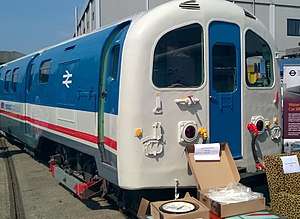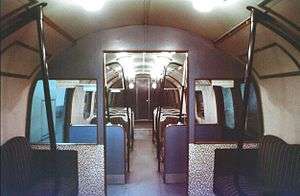British Rail Class 487
The British Rail Class 487 electric multiple units were built by English Electric in 1940, for use on the Waterloo & City line.
| British Rail Class 487 | |
|---|---|
 Class 487 at London Transport Museum following exterior refurbishment | |
 The interior of a Class 487 DMBSO, looking towards the driving cab at the Bank end, with the 'hump' over the powered bogie. | |
| In service | 1940-1993 |
| Manufacturer | English Electric |
| Built at | Dick, Kerr works, Preston |
| Family name | Tube |
| Replaced | W&CR stock |
| Constructed | 1938-1940 |
| Entered service | 1940 |
| Scrapped | 1993 |
| Number built | 28 vehicles (12 DMBSO, 16 TSO) |
| Number preserved | 1 vehicle |
| Number scrapped | 27 vehicles |
| Formation | One DMBSO, or two DMBSO flanking up to 3 TSO |
| Fleet numbers | DMBSO: 51–62 TSO: 71–86 |
| Capacity | DMBSO: 40 seats, 40 standing TSO: 52 seats, 52 standing |
| Operator(s) | Southern Railway British Rail Southern Region Network SouthEast |
| Depot(s) | Waterloo (Waterloo & City line) |
| Line(s) served | Waterloo & City line |
| Specifications | |
| Car length | 47 ft 0 in (14 3⁄8 m) 49 ft 1 3⁄4 in (14.98 m) |
| Width | 8 ft 7 3⁄4 in (2.64 m) |
| Height | 9 ft 7 in (2.92 m) |
| Maximum speed | 35 mph (56 km/h) |
| Traction system | Two EE 190 hp (140 kW) traction motors per DMBSO |
| Power output | DMBSO: 380 hp (283 kW) |
| Electric system(s) | 660 V DC third rail |
| Current collection method | Contact shoe |
| UIC classification | DMBSO: Bo′2′ TSO:2′2′ |
| Track gauge | 4 ft 8 1⁄2 in (1,435 mm) standard gauge |
Twelve motor carriages (DMBSO), numbered 51–62, and sixteen trailers (TSO), numbered 71–86, were built. Trains were in various formations, from a single motor carriage, to pairs of motor cars with up to three intermediate trailers.
They were originally classified Class 453 under TOPS but were later reclassified Class 487.
The Waterloo & City line was operated as part of the BR Southern Region. Stock was painted in British Railways green livery, which was replaced by BR Blue in the 1970s, a rather smart version of all over blue with grey detailing. In 1986, the line came under the ownership of Network SouthEast, and their blue, red and white livery was applied.
The Class 487 units were unique on the British Rail network for a couple of reasons. They did not feature the normal yellow ends because the route they operated was entirely in tunnel where the darkness would render them pointless (the line did not integrate at all with the rest of the network). The units were only fitted with red lights at the ends, thus the front of the train displayed two red lights instead of the more usual white.
By the 1990s the units were urgently in need of replacing. This came in the form of new Class 482 two-car units, which were delivered to traffic in 1992/93. The final Class 487 vehicles were taken by road to Glasgow for scrap, which was their single longest journey above ground. One vehicle, DMBSO no. 61, was initially stored at the National Railway Museum in York, before being subsequently transferred to the London Transport Museum's Acton Depot. This vehicle has had a major internal and external restoration by the London Transport Museum to have it in the condition it was on the day it left service in 1993.[1]
Gallery
 Class 487 vehicle alongside a 1967 Stock unit at the London Transport Museum depot in Acton
Class 487 vehicle alongside a 1967 Stock unit at the London Transport Museum depot in Acton A Class 487 Waterloo & City line driving motor carriage in Network SouthEast livery being stored near to the National Railway Museum in York. These featured just three passenger doors per side - arranged as a pair and a single.
A Class 487 Waterloo & City line driving motor carriage in Network SouthEast livery being stored near to the National Railway Museum in York. These featured just three passenger doors per side - arranged as a pair and a single. The internal air vents at the carriage ends on the Class 487 Waterloo & City line driving motor carriages featured a 'Southern Railway' logo, whilst on the trailers the logo was 'Southern Region'.
The internal air vents at the carriage ends on the Class 487 Waterloo & City line driving motor carriages featured a 'Southern Railway' logo, whilst on the trailers the logo was 'Southern Region'. Inside a Class 487 Waterloo & City line driving motor carriage
Inside a Class 487 Waterloo & City line driving motor carriage Class 487 Waterloo & City line trailer second open carriage in BR Blue. Unlike the driving motors these featured two sets of twin sliding passenger doors.
Class 487 Waterloo & City line trailer second open carriage in BR Blue. Unlike the driving motors these featured two sets of twin sliding passenger doors. Inside a Class 487 Waterloo & City line trailer second open carriage
Inside a Class 487 Waterloo & City line trailer second open carriage Interior of a Class 487 train
Interior of a Class 487 train.jpg) No. 61 at the LT Museum Depot
No. 61 at the LT Museum Depot Empty Class 487 stock, at the old sidings near Waterloo station, in 1988. Two trailers and one motor coach are shown in the original painting scheme.
Empty Class 487 stock, at the old sidings near Waterloo station, in 1988. Two trailers and one motor coach are shown in the original painting scheme.
Fleet Details
| Class | Operator | No. Built | Year Built | Cars per Set | Unit nos. | BR Design Code | Notes |
|---|---|---|---|---|---|---|---|
| Class 487 | Southern Railway Southern Region Network SouthEast |
12 | 1940 | 1 | 51-62 | EB260 / SR842 | DMBSO - could operate independently |
| 16 | 71-86 | EH260 / SR846 | TSO - could only operate with DMBSO |
References
- Waterloo & City line Car SR61, built 1940 (Sign). London Transport Museum. 2018.
- Marsden, Colin J. (1983). Southern Electric Multiple-Units 1898–1948. Shepperton, Surrey: Ian Allan Limited. pp. 65–70. ISBN 0-7110-1253-9.
External links
| Wikimedia Commons has media related to British Rail Class 487. |